-
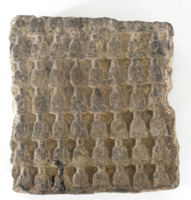 Wall fragment with multiple Buddhas from the Longmen Grottoes
Wall fragment with multiple Buddhas from the Longmen Grottoes This wall fragment comes from the Longmen Caves in Henan province, eastern China; In the first half of the 20th century, antique dealers colluded with foreigners, leading to the extensive looting and vandalism of the Longmen Grottoes. This wall with multiple Buddhas is one of the artifacts stolen during that period.
-
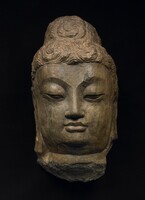 Stone Head of Buddha
Stone Head of Buddha this head comes from the Longmen Caves in Henan province, eastern China; In the first half of the 20th century, antique dealers colluded with foreigners, leading to the extensive looting and vandalism of the Longmen Grottoes. This stone head of Buddha is one of the artifacts stolen during that period.
-
 Jade Mountain Illustrating the Gathering of Scholars at the Lanting Pavilion
Jade Mountain Illustrating the Gathering of Scholars at the Lanting Pavilion This jade boulder is the largest piece of historic carved jade outside of China; It depicts a literary gathering of scholar-officials at Lanting; It lost from the Yuanmingyuan in 1860 and later acquired by an American buyer. It is currently collected in the Minneapolis Institute of Art in the state of Minnesota, United States.
-
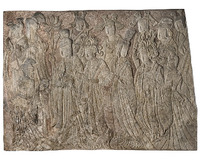 Offering Procession of the Empress as Donor with Her Court
Offering Procession of the Empress as Donor with Her Court Together with a companion piece showing an emperor Xiaowen and his entourage (now in the Metropolitan Museum of Art, New York City); It depicts Empress Wenzhao of Wei, positioned at the center, walking slowly on the path of paying respects to Buddha under the guidance of her court; In 1935, the antique dealer colluded with foreigners to pilfer artifacts from the Beijing Liuli Factory.
-
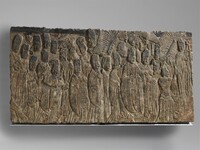 Emperor Xiaowen and his entourage worshipping the Buddha
Emperor Xiaowen and his entourage worshipping the Buddha Together with a companion piece showing an empress and her attendants (now in the Nelson-Atkins Museum of Art, Kansas City); It depicts Emperor Xiaowen of Wei, positioned at the center, walking slowly on the path of paying respects to Buddha under the guidance of a monk; In 1935, the antique dealer colluded with foreigners to pilfer artifacts from the Beijing Liuli Factory.
-
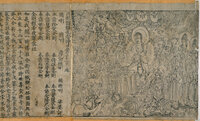 The Diamond Sutra Frontispiece
The Diamond Sutra Frontispiece The image depicts the frontispiece to the earliest complete block printed ‘book’ found up to now which contains a date; It was originally housed in the Mogao Caves in Dunhuang, In 1907, the British explorer Aurel Stein illicitly removed numerous Buddhist scriptures, documents, paintings, among them the Diamond Sutra Frontispiece.
-
 The thirteen emperors
The thirteen emperors It depicts the images of thirteen emperors. After the Xinhai Revolution, a large number of cultural relics from the Forbidden City were taken away or sold by Puyi, with this painting also lost to the public.; the painting came into the possession of Liang Hongzhi, a collaborator, who then sold them to Yamanaka; Eventually, Yamanaka donated the painting to the Museum of Fine Arts in Boston.
-
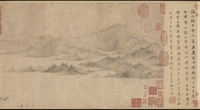 Imaginary Tour through Xiaoxiang
Imaginary Tour through Xiaoxiang This painting depicts the extraordinary scenery of Xiaoxiang at that time. It is an ink landscape painting on paper created by a painter surnamed Li during the Southern Song Dynasty for the reclusive Zen monk Yunguyuanzhao, classified as a national treasure of great significance; Before the fall of the Qing Dynasty, it flowed into Japan; The specific details of the loss event are still pending verification.
-
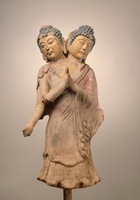 Double-Headed Buddha
Double-Headed Buddha In 1908, a team officially dispatched by the Qing government and ostensibly under the auspices of the Russian Geographical Society set out on a scientific expedition to specifically enrich themselves by plundering precious artifacts from various regions. Among the treasures seized was the unique masterpiece of the Western Xia Dynasty, the double-headed Buddha statue originally intended as a vessel of faith in the Buddha.
-
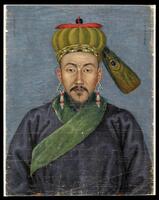 Portrait of the Mongolian Prince Corgiyamz’an
Portrait of the Mongolian Prince Corgiyamz’an The depiction of the Mongolian prince portrait known as Corgi Yamz'an, hailing from the Hall of Purple Light in Beijing, surfaced in the aftermath of the Boxer Rebellion when it became available for acquisition at a prestigious art emporium in Berlin. Currently, the portrait is in the collection of the Ethnological Museum in Berlin and considered as potential loot from the Boxer Rebellion around 1900.
-
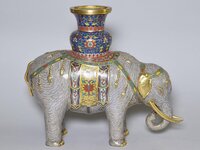 Figure of Elephant
Figure of Elephant Gilt metal, in the form of an elephant with a vase on its back, decorated with cloisonne enamel; In 1860, during the burning of the Old Summer Palace by the British and French forces, this figure was looted.
-
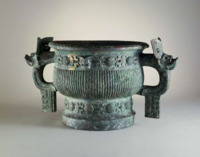 Kang Hou Gui
Kang Hou Gui Bronze ritual vessel of the type known as Gui (簋); After being resold overseas during war, it was donated to the British Museum by Brooke Sewell in 1977.
-
Red and White Hibiscuses
This work is considered the pinnacle of Southern Song imperial art flower and bird painting; Originally from the Old Summer Palace Collection; After the "Burning of the Old Summer Palace" in 1860, it was plundered by forces and lost overseas.
-
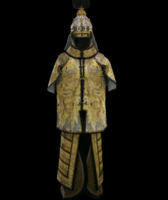 Parade Armor of Emperor Qiun-Long
Parade Armor of Emperor Qiun-Long Ceremonial piece called “war clothing” worn by the emperor during grandiose military parades organized in the courtyard of the imperial residence; In 1860, during the burning of the Old Summer Palace by the Anglo-French expedition forces, this suit of armor was looted by French soldiers and taken to France.
-
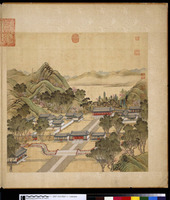 Forty Scenes of the Yuanmingyuan
Forty Scenes of the Yuanmingyuan It depicts historically recognized vistas in the Old Summer Palace in Beijing, China; In 1860, during the burning of the Old Summer Palace by the British and French forces, this valuable set of painting was looted and presented to the French Emperor Napoleon III.
-
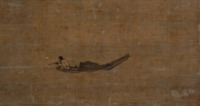 Solitary Angler On The Wintery River
Solitary Angler On The Wintery River This work depicts an angler in a small boat is drawn in a vast and cold river; Originally collected in the Old Summer Palace; It was plundered by Japan during the chaos of the burning of the Old Summer Palace by foreign forces in 1860.
-
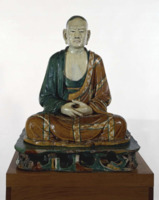 Arhat (Luohan) Figure
Arhat (Luohan) Figure Life-size sculpture; Part of a group of sixteen figures from Emei Temple, Baiyu Mountain, Yi county, Hebei Province, China; During the early years of the Republic of China, several sculptures were stolen and damaged, with all ten remaining ones currently lost overseas.
-
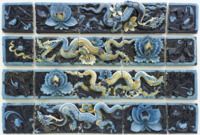 Fahua-type Decoration Glazed Ceramic Tiles
Fahua-type Decoration Glazed Ceramic Tiles Group of twenty glazed ceramic tiles, originally from two buildings; It used to be an ornament on the roofs of temples in Shanxi. During the late Qing Dynasty and early Republic of China period in the early 20th century, it was stolen and shattered, then arranged into wall panels for preservation.
-
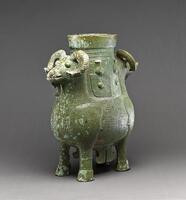 Double-ram Zun
Double-ram Zun Bronze vessel in the shape of a jar flanked by the heads and forequarters of two rams, with curling and rounded horns, and bodies covered with a pattern of scales; It originally belonged to the collection of the Old Summer Palace. After the "Burning of the Old Summer Palace" in 1860, it was plundered by the British and French forces and lost overseas. The other one is hidden in the Nezu Museum of Art in Japan.
-
 The Admonitions Scroll
The Admonitions Scroll Handscroll painting in nine scenes (originally twelve) illustrating the 'Nüshi zhen', a text composed by Zhang Hua; One of the earliest known Chinese painting scrolls; In 1900, it was looted by the British troops stationed in the Summer Palace by the Eight-Power Allied Forces and sold to the British Museum for 25 pounds.
 Wall fragment with multiple Buddhas from the Longmen Grottoes This wall fragment comes from the Longmen Caves in Henan province, eastern China; In the first half of the 20th century, antique dealers colluded with foreigners, leading to the extensive looting and vandalism of the Longmen Grottoes. This wall with multiple Buddhas is one of the artifacts stolen during that period.
Wall fragment with multiple Buddhas from the Longmen Grottoes This wall fragment comes from the Longmen Caves in Henan province, eastern China; In the first half of the 20th century, antique dealers colluded with foreigners, leading to the extensive looting and vandalism of the Longmen Grottoes. This wall with multiple Buddhas is one of the artifacts stolen during that period. Stone Head of Buddha this head comes from the Longmen Caves in Henan province, eastern China; In the first half of the 20th century, antique dealers colluded with foreigners, leading to the extensive looting and vandalism of the Longmen Grottoes. This stone head of Buddha is one of the artifacts stolen during that period.
Stone Head of Buddha this head comes from the Longmen Caves in Henan province, eastern China; In the first half of the 20th century, antique dealers colluded with foreigners, leading to the extensive looting and vandalism of the Longmen Grottoes. This stone head of Buddha is one of the artifacts stolen during that period. Jade Mountain Illustrating the Gathering of Scholars at the Lanting Pavilion This jade boulder is the largest piece of historic carved jade outside of China; It depicts a literary gathering of scholar-officials at Lanting; It lost from the Yuanmingyuan in 1860 and later acquired by an American buyer. It is currently collected in the Minneapolis Institute of Art in the state of Minnesota, United States.
Jade Mountain Illustrating the Gathering of Scholars at the Lanting Pavilion This jade boulder is the largest piece of historic carved jade outside of China; It depicts a literary gathering of scholar-officials at Lanting; It lost from the Yuanmingyuan in 1860 and later acquired by an American buyer. It is currently collected in the Minneapolis Institute of Art in the state of Minnesota, United States. Offering Procession of the Empress as Donor with Her Court Together with a companion piece showing an emperor Xiaowen and his entourage (now in the Metropolitan Museum of Art, New York City); It depicts Empress Wenzhao of Wei, positioned at the center, walking slowly on the path of paying respects to Buddha under the guidance of her court; In 1935, the antique dealer colluded with foreigners to pilfer artifacts from the Beijing Liuli Factory.
Offering Procession of the Empress as Donor with Her Court Together with a companion piece showing an emperor Xiaowen and his entourage (now in the Metropolitan Museum of Art, New York City); It depicts Empress Wenzhao of Wei, positioned at the center, walking slowly on the path of paying respects to Buddha under the guidance of her court; In 1935, the antique dealer colluded with foreigners to pilfer artifacts from the Beijing Liuli Factory. Emperor Xiaowen and his entourage worshipping the Buddha Together with a companion piece showing an empress and her attendants (now in the Nelson-Atkins Museum of Art, Kansas City); It depicts Emperor Xiaowen of Wei, positioned at the center, walking slowly on the path of paying respects to Buddha under the guidance of a monk; In 1935, the antique dealer colluded with foreigners to pilfer artifacts from the Beijing Liuli Factory.
Emperor Xiaowen and his entourage worshipping the Buddha Together with a companion piece showing an empress and her attendants (now in the Nelson-Atkins Museum of Art, Kansas City); It depicts Emperor Xiaowen of Wei, positioned at the center, walking slowly on the path of paying respects to Buddha under the guidance of a monk; In 1935, the antique dealer colluded with foreigners to pilfer artifacts from the Beijing Liuli Factory. The Diamond Sutra Frontispiece The image depicts the frontispiece to the earliest complete block printed ‘book’ found up to now which contains a date; It was originally housed in the Mogao Caves in Dunhuang, In 1907, the British explorer Aurel Stein illicitly removed numerous Buddhist scriptures, documents, paintings, among them the Diamond Sutra Frontispiece.
The Diamond Sutra Frontispiece The image depicts the frontispiece to the earliest complete block printed ‘book’ found up to now which contains a date; It was originally housed in the Mogao Caves in Dunhuang, In 1907, the British explorer Aurel Stein illicitly removed numerous Buddhist scriptures, documents, paintings, among them the Diamond Sutra Frontispiece. The thirteen emperors It depicts the images of thirteen emperors. After the Xinhai Revolution, a large number of cultural relics from the Forbidden City were taken away or sold by Puyi, with this painting also lost to the public.; the painting came into the possession of Liang Hongzhi, a collaborator, who then sold them to Yamanaka; Eventually, Yamanaka donated the painting to the Museum of Fine Arts in Boston.
The thirteen emperors It depicts the images of thirteen emperors. After the Xinhai Revolution, a large number of cultural relics from the Forbidden City were taken away or sold by Puyi, with this painting also lost to the public.; the painting came into the possession of Liang Hongzhi, a collaborator, who then sold them to Yamanaka; Eventually, Yamanaka donated the painting to the Museum of Fine Arts in Boston. Imaginary Tour through Xiaoxiang This painting depicts the extraordinary scenery of Xiaoxiang at that time. It is an ink landscape painting on paper created by a painter surnamed Li during the Southern Song Dynasty for the reclusive Zen monk Yunguyuanzhao, classified as a national treasure of great significance; Before the fall of the Qing Dynasty, it flowed into Japan; The specific details of the loss event are still pending verification.
Imaginary Tour through Xiaoxiang This painting depicts the extraordinary scenery of Xiaoxiang at that time. It is an ink landscape painting on paper created by a painter surnamed Li during the Southern Song Dynasty for the reclusive Zen monk Yunguyuanzhao, classified as a national treasure of great significance; Before the fall of the Qing Dynasty, it flowed into Japan; The specific details of the loss event are still pending verification. Double-Headed Buddha In 1908, a team officially dispatched by the Qing government and ostensibly under the auspices of the Russian Geographical Society set out on a scientific expedition to specifically enrich themselves by plundering precious artifacts from various regions. Among the treasures seized was the unique masterpiece of the Western Xia Dynasty, the double-headed Buddha statue originally intended as a vessel of faith in the Buddha.
Double-Headed Buddha In 1908, a team officially dispatched by the Qing government and ostensibly under the auspices of the Russian Geographical Society set out on a scientific expedition to specifically enrich themselves by plundering precious artifacts from various regions. Among the treasures seized was the unique masterpiece of the Western Xia Dynasty, the double-headed Buddha statue originally intended as a vessel of faith in the Buddha. Portrait of the Mongolian Prince Corgiyamz’an The depiction of the Mongolian prince portrait known as Corgi Yamz'an, hailing from the Hall of Purple Light in Beijing, surfaced in the aftermath of the Boxer Rebellion when it became available for acquisition at a prestigious art emporium in Berlin. Currently, the portrait is in the collection of the Ethnological Museum in Berlin and considered as potential loot from the Boxer Rebellion around 1900.
Portrait of the Mongolian Prince Corgiyamz’an The depiction of the Mongolian prince portrait known as Corgi Yamz'an, hailing from the Hall of Purple Light in Beijing, surfaced in the aftermath of the Boxer Rebellion when it became available for acquisition at a prestigious art emporium in Berlin. Currently, the portrait is in the collection of the Ethnological Museum in Berlin and considered as potential loot from the Boxer Rebellion around 1900. Figure of Elephant Gilt metal, in the form of an elephant with a vase on its back, decorated with cloisonne enamel; In 1860, during the burning of the Old Summer Palace by the British and French forces, this figure was looted.
Figure of Elephant Gilt metal, in the form of an elephant with a vase on its back, decorated with cloisonne enamel; In 1860, during the burning of the Old Summer Palace by the British and French forces, this figure was looted. Kang Hou Gui Bronze ritual vessel of the type known as Gui (簋); After being resold overseas during war, it was donated to the British Museum by Brooke Sewell in 1977.
Kang Hou Gui Bronze ritual vessel of the type known as Gui (簋); After being resold overseas during war, it was donated to the British Museum by Brooke Sewell in 1977. Parade Armor of Emperor Qiun-Long Ceremonial piece called “war clothing” worn by the emperor during grandiose military parades organized in the courtyard of the imperial residence; In 1860, during the burning of the Old Summer Palace by the Anglo-French expedition forces, this suit of armor was looted by French soldiers and taken to France.
Parade Armor of Emperor Qiun-Long Ceremonial piece called “war clothing” worn by the emperor during grandiose military parades organized in the courtyard of the imperial residence; In 1860, during the burning of the Old Summer Palace by the Anglo-French expedition forces, this suit of armor was looted by French soldiers and taken to France. Forty Scenes of the Yuanmingyuan It depicts historically recognized vistas in the Old Summer Palace in Beijing, China; In 1860, during the burning of the Old Summer Palace by the British and French forces, this valuable set of painting was looted and presented to the French Emperor Napoleon III.
Forty Scenes of the Yuanmingyuan It depicts historically recognized vistas in the Old Summer Palace in Beijing, China; In 1860, during the burning of the Old Summer Palace by the British and French forces, this valuable set of painting was looted and presented to the French Emperor Napoleon III. Solitary Angler On The Wintery River This work depicts an angler in a small boat is drawn in a vast and cold river; Originally collected in the Old Summer Palace; It was plundered by Japan during the chaos of the burning of the Old Summer Palace by foreign forces in 1860.
Solitary Angler On The Wintery River This work depicts an angler in a small boat is drawn in a vast and cold river; Originally collected in the Old Summer Palace; It was plundered by Japan during the chaos of the burning of the Old Summer Palace by foreign forces in 1860. Arhat (Luohan) Figure Life-size sculpture; Part of a group of sixteen figures from Emei Temple, Baiyu Mountain, Yi county, Hebei Province, China; During the early years of the Republic of China, several sculptures were stolen and damaged, with all ten remaining ones currently lost overseas.
Arhat (Luohan) Figure Life-size sculpture; Part of a group of sixteen figures from Emei Temple, Baiyu Mountain, Yi county, Hebei Province, China; During the early years of the Republic of China, several sculptures were stolen and damaged, with all ten remaining ones currently lost overseas. Fahua-type Decoration Glazed Ceramic Tiles Group of twenty glazed ceramic tiles, originally from two buildings; It used to be an ornament on the roofs of temples in Shanxi. During the late Qing Dynasty and early Republic of China period in the early 20th century, it was stolen and shattered, then arranged into wall panels for preservation.
Fahua-type Decoration Glazed Ceramic Tiles Group of twenty glazed ceramic tiles, originally from two buildings; It used to be an ornament on the roofs of temples in Shanxi. During the late Qing Dynasty and early Republic of China period in the early 20th century, it was stolen and shattered, then arranged into wall panels for preservation. Double-ram Zun Bronze vessel in the shape of a jar flanked by the heads and forequarters of two rams, with curling and rounded horns, and bodies covered with a pattern of scales; It originally belonged to the collection of the Old Summer Palace. After the "Burning of the Old Summer Palace" in 1860, it was plundered by the British and French forces and lost overseas. The other one is hidden in the Nezu Museum of Art in Japan.
Double-ram Zun Bronze vessel in the shape of a jar flanked by the heads and forequarters of two rams, with curling and rounded horns, and bodies covered with a pattern of scales; It originally belonged to the collection of the Old Summer Palace. After the "Burning of the Old Summer Palace" in 1860, it was plundered by the British and French forces and lost overseas. The other one is hidden in the Nezu Museum of Art in Japan. The Admonitions Scroll Handscroll painting in nine scenes (originally twelve) illustrating the 'Nüshi zhen', a text composed by Zhang Hua; One of the earliest known Chinese painting scrolls; In 1900, it was looted by the British troops stationed in the Summer Palace by the Eight-Power Allied Forces and sold to the British Museum for 25 pounds.
The Admonitions Scroll Handscroll painting in nine scenes (originally twelve) illustrating the 'Nüshi zhen', a text composed by Zhang Hua; One of the earliest known Chinese painting scrolls; In 1900, it was looted by the British troops stationed in the Summer Palace by the Eight-Power Allied Forces and sold to the British Museum for 25 pounds.